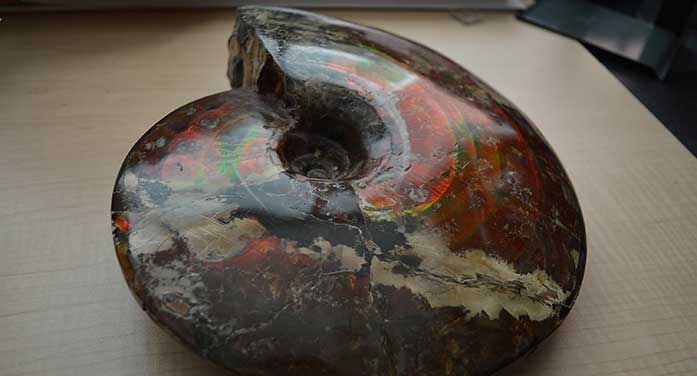Alberta may soon be getting an official gemstone, as the provincial government recently announced its intention to add ammolite to the Emblems of Alberta Act, along with current emblems such as the wild rose and petrified wood, Alberta’s official flower and stone.

Lisa Budney
Though ammolite wasn’t officially recognized as a gemstone until 1981, it’s been around far longer than that. The rock in which ammolite is found is anywhere from 72 million to 75 million years old, according to Lisa Budney, collections and museums administrator in the Department of Earth and Atmospheric Sciences.
Ammolite comes from the fossilized shells of ammonites, extinct molluscs that lived in the Bearpaw Sea, a body of water that once covered most of southern Alberta and was part of an ancient inland seaway that split North America in two and ran from the Arctic Ocean to the Gulf of Mexico.
However, not all ammonites have ammolite. As Budney explained, it’s thought that the gem’s exclusivity to Alberta owes itself to the particular conditions under which the rock around the ammonite formed and the way the specimens were preserved.
“Mineralization will start to happen around the fossil, and you end up with this ball of rock called a concretion encasing the fossil. The best quality gem material is usually inside these concretions,” said Budney.

A sample of an ammonite fossil containing ammolite. The iridescent effect results from light reflecting from different layers within the fossilized shell. (Photo: Supplied)
Alberta is the only place in the world where ammolite is mined commercially, and the Bearpaw Formation in southern Alberta is home to the highest quality of ammolite. The shores of the Oldman River and the St. Mary River are where ammolite is typically mined, Budney noted.
Ammolite is prized for its iridescent appearance, a result of alternating layers of the mineral aragonite and the protein in the ammonites’ shells.
“When the light passes into the shell, it hits these different layers,” said Budney. “Then the light comes back to us and we see different colours. That’s what gives you the rainbow effect.”
It’s also naturally very soft and brittle. To be used in jewelry or other wares, ammolite must be stabilized with epoxy and is often capped with quartz to help protect it.
Selected pieces of broken ammonite fossils are traditionally used for healing, luck, and as part of healing ceremonies by Niitsitapi (Blackfoot) peoples. These ammonite fragments were given the name iniskim (buffalo calling stones) by the Niitsitapi.
The gemstone is also used in feng shui practices, according to Budney. As she explained, ammolite is thought to “hold the knowledge of the universe” and bring auspicious forces into the home.
When excavating the ammolite, whole shells are kept intact, and broken pieces and fragments are used to craft jewelry.
“Sales started in the 1960s when they figured out how to stabilize it so you could get long-lasting jewelry,” said Budney. “There’s increased prospecting recently, and an interest in expanding operations.”
| By Adrianna MacPherson
Adrianna is a reporter with the University of Alberta’s Folio online magazine. The University of Alberta is a Troy Media Editorial Content Provider Partner.
The opinions expressed by our columnists and contributors are theirs alone and do not inherently or expressly reflect the views of our publication.
© Troy Media
Troy Media is an editorial content provider to media outlets and its own hosted community news outlets across Canada.

